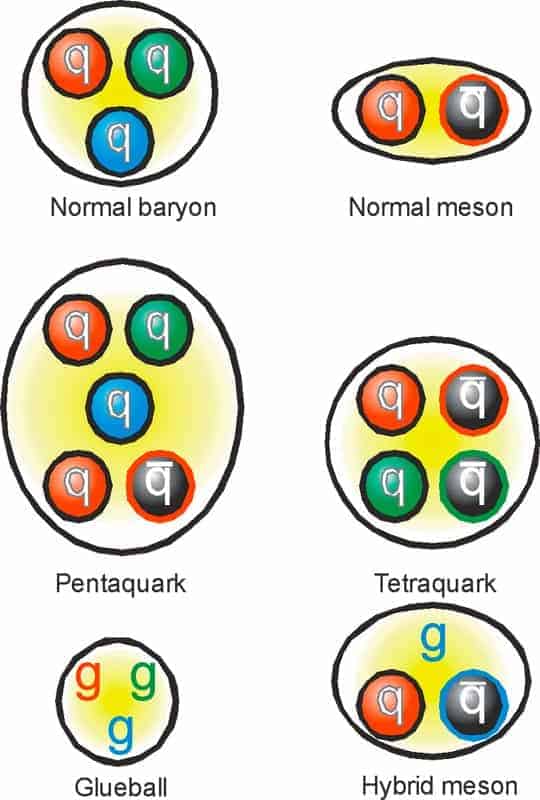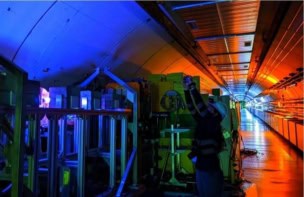
The existence of a new form of matter called a tetraquark has been given further support by the re-analysis of an experiment that has baffled particle physicists for the past two years.
In 2008 researchers on the BELLE experiment at the KEK Laboratory in Japan looked at how an excited state of the meson “bottomonium” decayed and were very surprised to find that one particular decay mode was much more common than expected.
Now, physicists in Germany and Pakistan have proposed an extraordinary explanation – instead of producing bottomonium, the experiment had created a new particle containing four quarks. If such tetraquarks do exist, it would lead to an extended quark model of exotic particles. It would also give physicists a deeper understanding of quantum chromodynamics (QCD) – the Standard Model’s theory of quarks and the strong force that binds them together.
In the 1960s physicists realized that hadrons – protons, neutrons, mesons and more – could be described in terms of their constituent quarks. Mesons form a bound state of a quark and antiquark pair, whereas baryons (including protons and neutrons) are made up of three quarks or three antiquarks. The quark model won its pioneer Murray Gell-Mann the 1969 Nobel Prize in Physics and has gone on to predict the existence and properties of many different hadrons.
Exotic bound states
However, QCD allows other, exotic bound states to exist. One of these is the tetraquark, which comprises two quarks and two antiquarks. For decades, particle physicists have been curious about the existence of tetraquarks, and in recent years experiments are becoming sensitive enough to see hints of them.
If tetraquarks exist, there’s a good chance that they will be seen by physicists working on electron–positron colliders at KEK in Japan and SLAC in California. Both facilities can be tuned to produce excited states of “heavy quarkonia” mesons such as bottomonium, which is made from bottom and anti-bottom quarks. Both BELLE and the BaBar experiment at SLAC are designed to measure the decays of these short-lived particles and search for small deviations from theoretical predictions. So far both experiments have spotted several unmistakable anomalies.
Baffling bottomonium results
In 2008 BELLE physicists were studying decays of the highly excited Y(5S) state of bottomonium. According to QCD, an excited state of Y will rarely decay into one of its less excited states and a pair of charged pi mesons (pions). However, when BELLE measured this decay channel for Y(5S), the observed rates were several orders of magnitude larger than expected.
One possible explanation is that the electron–positron collisions tuned to form Y(5S) may have actually been producing a different particle altogether – a tetraquark meson Yb(10890). Ahmed Ali and Christian Hambrock of the DESY Collaboration and Jamil Aslam, from Quaid-i-Azam University in Pakistan, have been investigating this hypothesis.
Ali explains why it makes sense: “If we assume that tetraquarks exist, we can consider what masses are possible, and how they will decay. We find that the Yb(10890), a tetraquark meson formed of an up flavour “diquark” (quark-antiquark pair) and a bottom flavour diquark, is very close in mass to Y(5S). It can decay to Y(2S) and a pion pair in several ways, and if we calculate these we find that it can reproduce the data.”
Though not conclusive, this evidence further supports the possibility that tetraquarks exist. “If established to be true”, says Ali, “this is a brand new form of matter.”
Mystery solved?
So is the mystery solved? Not quite, according to Hambrock, who explains: “This is an indication, but not proof. From this result alone we can’t be certain that the two diquarks were truly in a bound state.” There are also other ideas for what could be causing the increased rates, as BELLE’s co-spokesperson, Tom Browder of the University of Hawaii points out. “Perhaps some other mechanism [in the interaction of Y(5S)] could explain the results. We are experimentalists and have to keep an open mind.”
If Yb(10890) is the cause of the anomaly, there is another clue waiting to be uncovered according to Ali. “If we are right, it should actually be a combination of two barely distinguishable tetraquarks, the other formed of a down diquark and a bottom diquark, with an almost identical mass,” he explained. With a short data run scheduled in May this year, BELLE physicists will try to deduce whether Ali’s prediction is correct.
The research is described in Phys. Rev. Lett. 104 162001.




